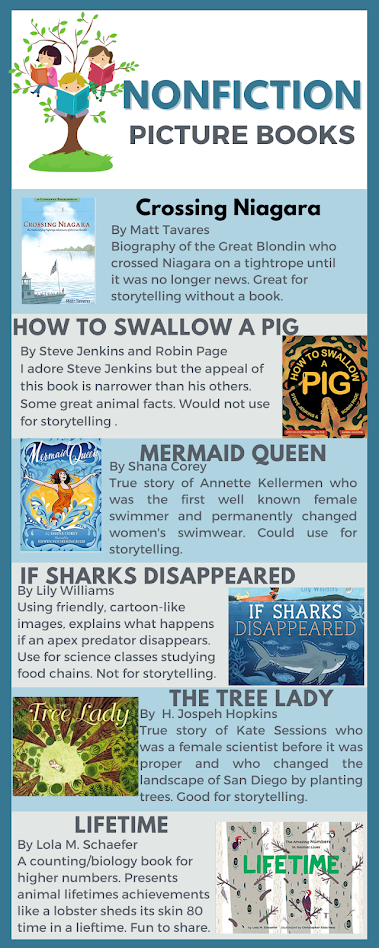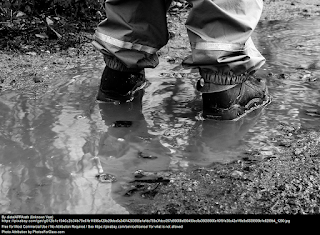Wells_Laura_Reading_Reflection
Assigned reading
This week we had to read nonfiction. My favorite genre as a school librarian is nonfiction picture books. I love using them with 3rd grade and above, even with high schoolers. They are such a wonderful introduction to a topic that kids often do not know about. I need to book talk and share these to get them into the kids hands because they can get overlooked. Considering nonfiction picture books from a storytelling perspective, changes their usefulness a bit.The books I read this week are on the left. I could envision using the picture book biographies for storytelling without the book and then showing some of the pictures afterward as Green and Del Negro suggest in our text (2010). Other books like How to Swallow a Pig won't work for storytelling without a book, would even be hard for a read aloud due to the broken up text. In this book the info is divided into short 2-3 sentence paragraphs with images scattered across the page. Kids love these kinds of informational reading, but they don't work great for storytelling. Some of the books I read, like Lifetime and If Sharks Disappeared have great curriculum content and could be shared with teachers. However, they would only work as a read aloud. I did note, that multiple times in our text, Greene and Del Negro say storytelling is for connection and fun and should not have didactic purposes only: "The first most important thing to remember about storytelling programs is to have fun" (Green et al., 2010, p. 216). This helped me remember that even though a book has curriculum content, it does not have to be part of story time. Kids can look at them on their own.
One thing that has been bouncing around in my head as the class has progressed is that the research in support of storytelling tends to be descriptive or anecdotal, similar to an observation made in Categorizing Library Public Programing (Barchas-Litchenstein et al., 2020). I've also noticed in general, that many of the exciting storytelling programs we have read about this semester ended due to lack of funding. To me this means that research supporting the impact of storytelling is necessary to secure long term funding and some kind of research that doesn't just have teachers rate the confidence of kids after participation is needed. But how do you measure the success or effectiveness of a program in a way that is not anecdotal?
I loved the article "Participation Palooza." The different books offered to increase participation are great. But she only offered a few books I didn't know about which means teachers know about these books too. So here's my next question, more of a troubling question this article reminded me of. In my district and much of elementary education I imagine, teachers are reading and sharing picture books daily all the way through 5th grade. Often, as a librarian, I have a plan only to discover that the teacher read the same book last week. Is it important to share new-to-the-audience stories? I feel like I am competing with the classroom teachers for the latest funny or participatory books. Should I focus on finger plays and folktales or fairy tales? Teachers tend to gravitate to the newest model. Maybe I should return to the classics? Since my readers are classmates who have to comment, let me know what you think.
"Participation Palooza," "Sensory Story Time" and "The Story is More Important than the Words" articles made me realize I could do a better job with my special needs groups. First, participation stories like the ones shared in "Participation Palooza!" are a must with this group and many of these stories, even if the kids know them, are successful. Too often I was guilty of grabbing a book and hoping they like it because I didn't really know how to engage these classes. 😞 I should be sure to put participation books
on my "to-buy" list. Second, our special ed classes tend to be small so I have time to teach these kids how to find the books they love. I can work with teachers and aids to create lists like Susan Grigsby does in "The Story is More Important than the Words" (2014). Lists can be created orally if writing/reading is hard for the student (aka Me or another staff could write it down). I could create recommended lists and keep a copy. I could help each kid check off a book when they check them out. We can add books or change the theme of the books. For example in the past, I remember Aiden always wanted to see dinosaur books. Krista always wanted Berenstain Bear books. I have too many kids (500) to make each kid a list, but I can do it for these classes. Making a list of all the dinosaur books would not be hard. I should have been better prepared to train these kids and their aids to find what they loved. I could easily post a schedule for the kids (all of them really) like they do in the Sensory Story Time video. I want the teachers, aids, and students of all kinds to feel welcome in my library and to have an opportunity to connect with books. I have some ideas now for how to do this better.There were multiple articles this week about cool storytelling partnerships with storytellers or authors. I am going to focus on "Aliens with Einstein Heads" (Watkins, et. al, 2012). The article describes multiple storytelling experiences where
professional authors or publishers paired with kids to create and publish their own stories. I loved this idea. I cannot imagine it in practicality. I cannot imagine finding the professionals to mentor the kids, and I am unsure how to chose who would get mentored? If you only have 6 authors and each takes 2 kids, do only 12 kids get to do the project? Also, while I believe we all have stories to tell, have you ever tried to coach a young kid to tell a story. Structure is nonexistent as they want to add trial after trial to the story. They can't end the story. Mentoring kids to tell stories is hard. It is easier for me to imagine this program with 5th or 6th graders when they have more grasp of the structure of a story. Disregarding my practical concerns, I really want to be part of this type of partnership where professionals mentor kids to tell stories. The program in this article was called Pigeons. The article ends with this statement that I adore: "The power of Pigeons lies in their recognition that children have stories to tell, imaginations rich with ideas and playfulness, and that the partnering of child and adult enables these stories to be shaped, shared and appreciated" (p. 63).
Akron Summit Library (2014, April 15). Sensory story time: A program designed for families of children with autism [Video]. YouTube. https://youtube/xwAT88XQsK4
Barchas-Lichtenstein, J., Norlander, R. J., Fraser, J., Fournier, M.D., Voiklis, J., Nock, K., & Danter, E. Categorizing library public programs. Library Quarterly, 90(4), 563-579.
Greene, E. & Del Negro, J.M. (2010). Storytelling: Art and technique (4th ed.). Libraries Unlimited.
Grigsby, S. (2014). The story is more important than the words. Knowledge Quest, 42(1), 22-28.
Pyzek, J. (2014, Spring). Participation palooza! Creating a festive storytime atmosphere with interactive books. Children & Libraries.
Watkins, M., MacIntyre, P. , & Grant, G. (2012). Aliens with Einstein heads. The International Journal of the Book, 9 (3), 53-65.


.png)



Hi Laura!
ReplyDeleteI love how you made your own graphic of the nonfiction books you read! Unlike you, I typically will read fiction picture books to children. When planning for storytimes, I always choose picture books because it's hard for me to find age-appropriate nonfiction books for a read aloud. The books are usually way too long and spit out a bunch of facts. When I start working with older children in my own school library, I will for sure use the nonfiction books you recommended on your blog. Like you said, recognizing that not every book works for storytelling and that's okay is a great skill to have. The questions you have about new books is something that I have as well. I tend to get excited about introducing a new book to children and will get down knowing that they have already read it in their classroom. I don't think there is a specific answer to this problem other than planning a lesson with the teacher and ask them what books they have and haven't read as a class. I enjoyed your blog this week and you raised thought-provoking questions!
Kacee
Hello Laura!
ReplyDeleteYou ask a lot of great questions in your post this week, and you brought up a few great points that got me thinking. First, I want to respond to your question about novelty and storytimes. I can imagine it is hard to find a new, engaging book that children haven't heard from their parents, teachers, or public libraries. I don't think that that devalues programs that feature those familiar books, though. My nephew often requests the same book over and over, and I know that he loves the familiarity as much as the story. I also think that there's a lot of opportunity to make even the most familiar story new. While researching storytimes for this semester, I made a habit of watching different versions of the same story. Each telling was vastly different, and I found myself having different reactions to different tellings. By using different moments for interactions, follow up activities, and pacing, it's possible to make the old new. So, while I think it is great to seek out original content for stories, I think it's ok to just add a fresh take to an old favorite.
I also really loved your thoughts on resource lists. You mentioned that it would be easy to create a subject list on dinosaurs, and it made me think think a lot about what is and isn't possible for librarians. As you mentioned, it is impossible for you to create an individual list for each student, but, as you mentioned, you could create a few subject lists easily. For librarians with little help and lots of students, it may be more time effective to create general subject lists that all students can access. Then they can continually be added to, reused from year to year, and shared with teachers. It's nowhere near as individualized, but it could absolutely help a reader find new content.
Thanks for sharing!
Jessica